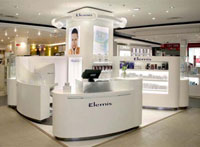The sign above the entrance may say Macy’s, Nordstrom or Neiman Marcus, but the salespeople behind the cosmetics counters inside do not work for the store at all. Instead, the perfume spritzers and skincare advisors actually work for brand name cosmetics manufacturers in space leased from the marquee retailers.
In an arrangement that is common for many product categories in stores across Asia and in other parts of the world, U.S. department store retailers often cede the cosmetics category to branded manufacturers in return for fees paid to occupy prime retail real estate. New Wharton research looks into the dynamics of these manufacturer-run shops operating under the roof of traditional retailers. In a paper titled, “Store-within-a-Store,” recently published in the Journal of Marketing Research, Wharton marketing professor Z. John Zhang and Kinshuk Jerath of the Tepper School of Business at Carnegie Mellon University examine the economic incentives and conditions that make the store-within-a-store arrangement attractive to retailers and manufacturers.
The researchers built theoretical models to explore many elements of the arrangement, including the type of product, the cost of providing service and the overall competitive retail climate. “The store-within-a-store has the effect of stabilizing the price competition across all retailers. This [is] very important if the retailing market is very competitive,” says Zhang.
He became interested in the store-within-a-store concept when a top executive from LG China, a subsidiary of LG, the Korean electronics manufacturer, took a side trip to a Best Buy during a visit to Wharton. The LG executive wondered why electronics manufacturers were not operating their own stores within Best Buy as they do in Chinese stores.
Zhang and Jerath were curious, too. They began to discuss the phenomenon with retailers in the United States and China, and found that the arrangement seems to be popular in certain circumstances but not others, and that little theoretical work had been done on the topic. Zhang and Jerath set out to explore when the conditions would be best for manufacturers and retailers to adopt the store-within-a-store model and when retailers would want to maintain the traditional relationship in which they buy goods wholesale from manufacturers and market them in their stores.
The paper describes three types of retailer-manufacturer relationships to determine when the store-within-a-store concept makes sense and when the traditional pattern should prevail.
The traditional arrangement is identified as the retailer-resell or RR model in the paper. In this case, retailers buy products from manufacturers who compete at the wholesale level. According to the model, this system results in higher prices for consumers because the profit margin must be split between the manufacturer and the retailer.
With a store-within-a-store arrangement, referred to as the SS arrangement in the paper, manufacturers compete against one another on price and on in-store service, but because the retailer does not take an additional markup, the manufacturers are willing to keep prices lower. In turn, the model shows, they will reap higher sales and enjoy a stronger bottom line. The arrangement, which is typical in U.S. cosmetics retailing, works for department stores because if the manufacturers are doing well, the retailers can charge higher rental fees. “There’s a sweet spot where they can make more profit even at a lower price because more cosmetics are being sold,” notes Jerath.
Lipstick vs. Frying Pans
A key variable, however, is the degree to which consumers can easily substitute one product for another. Cosmetics and high-end apparel are deeply identified with specific brands in consumers’ minds and are not easily interchangeable. “When the consumer perceives substitutability is low, that’s when you will see the store-within-a-store,” says Jerath. “With cosmetics — a Chanel lipstick, for example — substitutability is low, at least when compared to frying pans.”
The paper points to other research citing examples of high-end apparel boutiques operated as stores-within-a-store at U.S. retailers: Bloomingdale’s has had stores-within-a-store for brands such as Ralph Lauren, Calvin Klein, DKNY and Kenneth Cole. Marshall Field’s — now operating as Macy’s — has housed Louis Vuitton, Thomas Pink, BCBG and Jil Sander. Neiman Marcus has Armani and Gucci. Nordstrom has Chanel, Chloe and YSL.
For more routine, easily substituted items, retailers usually choose to maintain control over pricing and service. “For most categories, like kitchenware and housewares, we observe only the standard arrangement wherein the retailer purchases the products from competing suppliers at a wholesale price and then sets the retail prices for all products,” the paper states. “In this case, the retailer also appoints its own in-store service representatives for the category and decides the level of in-store service to be provided for each brand.”
A third approach is what the researchers call the retailer-store-within-a-store, or RS model. This is a hybrid of the two other models and is sometimes used in low- to mid-priced apparel or toys. In this case, one brand operates a store-within-a-store competing against products sold in the traditional retailer-resell system. “An interesting insight that we obtain from the model is that, for the RS arrangement, the level of service provided for the store-within-a-store product is higher than that for the retailer-resell product,” the paper states. “This is because the margin to the manufacturer for the store-within-a-store product is higher than the margin to the retailer for the retailer-resell product.”
When it comes to service, the researchers find that the ability to substitute products again plays into the decision of whether to open a store-within-a-store. “The SS arrangement can be a two-edged sword,” according to the paper. If the need to charge two margins is removed and if products are well differentiated, then service levels — along with prices and profits — are high. As the products become more substitutable, both prices and service levels go down and profits follow, the model predicts. “The more expensive service is in a category, the store-within-a-store will be seen more often,” Jerath says. “Cosmetics service is definitely more expensive, while pots and pans require very little service.”
The paper also discusses the effect of stores-within-a-store on overall retail traffic. It is apparently not a coincidence that cosmetics — the strongest example of stores-within-a-store in U.S. retailing — are positioned near the entrance to department stores, points out Jerath. “If it drives more people into the store, it’s attractive. In the model, we allow for store traffic effects. If a store-within-a-store brings more traffic into the store, retailers will go for it more often.”
Zhang and Jerath’s research emphasizes the importance of factoring in overall retailer power in weighing whether to create a store-within-a-store. The paper notes that in the last two decades, retail power has grown increasingly concentrated in the United States. According to the U.S. Census Bureau, only a few retail chains, each with more than a hundred stores, accounted for 43% of sales as of 2002. As a result, retailers hold more sway over manufacturers.
According to Jerath, much of the academic research examining the relationship between manufacturers and retailers assumes that since the manufacturers control the end-product, they have the power to dictate terms. “We know that Macy’s and Wal-Mart are big retailers with a lot of customer following. So they are in the position to actually more or less dictate terms to manufacturers,” he notes. “The manufacturer wants access to this customer base. The retailers really have more power in the bargaining.”
In many cases, adjacent retailers in shopping malls use store-within-a-store formats. The authors also built a model to examine this form of competition, and found that the store-within-a-store concept can work even at this level of competition under the right conditions.
“In fact, stores-within-a-store can help to reduce inter-store competition to the benefit of competing retailers when inter-brand substitutability is small,” the paper states. “However, when inter-brand substitutability and inter-store substitutability are both large, the store-within-a-store arrangement can lead to a prisoner’s dilemma situation where both competing retailers are in this arrangement but are also worse off because of it.”
Zhang says lower retail competition in the United States is probably why the store-within-a-store is more prevalent in Asia and Europe, where retail competition remains fierce. “In Asian markets, retail outlets are very close to each other, and it is a lot more important for the retailer to cushion its price competition by charging the manufacturer for entry into its floor space.”
While U.S. retailers dominating a particular product category, like Best Buy, may complain about harsh competition, the lack of store-within-a-store opportunities may indicate that the competition is at least not as strong as in other parts of the world, he adds.
The researchers note that some of the underlying concepts developed through their models are also evident in retail operations that appoint “category captains” among their vendors to manage a single product category. For example, says Jerath, competing supermarket retailers may appoint Procter & Gamble as the “category captain” to manage its toothpaste business — everything from pricing and inventory to shelf placement. In this case, one manufacturer, Procter & Gamble, effectively does the merchandising for all participating retailers, which moderates competition among them.
A final emerging concept is the presence of retailers within other retail stores. Sephora, the cosmetics retailer, operates a store-within-a-store at JC Penney, and FAO Schwarz has a store at Saks Fifth Avenue, the research paper notes. Some of the findings of the store-within-a-store model may carry over into this type of arrangement. However, the authors point out, the retailer-within-a-retailer concept raises additional issues — such as the efficacy of cross-selling brands and service efficiencies in specialized categories. “The incentives driving this arrangement could be very different from the incentives driving manufacturer-run stores-within-a-store,” the paper concludes. “Exploring these and other scenarios is a fascinating direction” for further research.



